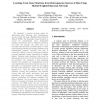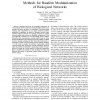325 search results - page 9 / 65 » Evolvable network architectures: what can we learn from biol... |
CSB
2005
IEEE
14 years 2 months ago
2005
IEEE
We developed a machine learning system for determining gene functions from heterogeneous sources of data sets using a Weighted Naive Bayesian Network (WNB). The knowledge of gene ...
BIBE
2006
IEEE
14 years 2 months ago
2006
IEEE
— Biological networks are formalized summaries of our knowledge about interactions among biological system components, like genes, proteins, or metabolites. From their global top...
BMCBI
2007
13 years 8 months ago
2007
Background: Much recent work in bioinformatics has focused on the inference of various types of biological networks, representing gene regulation, metabolic processes, protein-pro...
JMLR
2010
13 years 3 months ago
2010
Learning dynamic Bayesian network structures provides a principled mechanism for identifying conditional dependencies in time-series data. An important assumption of traditional D...
ICANN
2005
Springer
14 years 2 months ago
2005
Springer
Humans can recognize biological motion from strongly impoverished stimuli, like point-light displays. Although the neural mechanism underlying this robust perceptual process have n...


